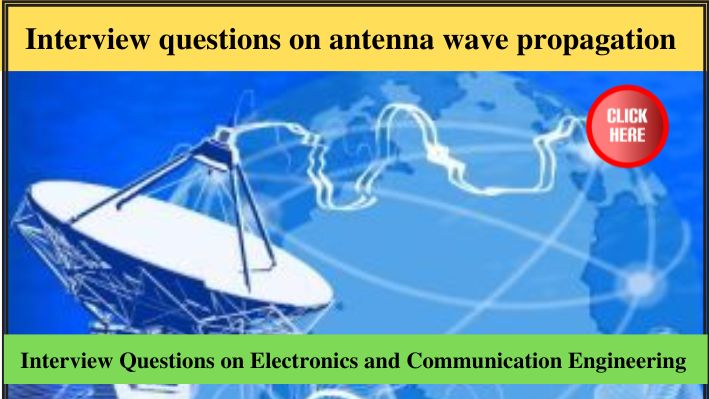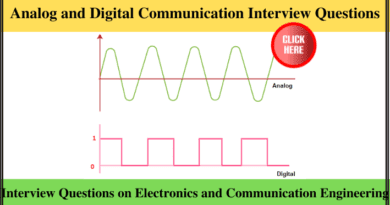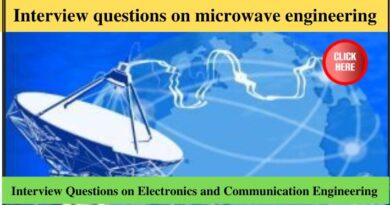Interview questions on antenna wave propagation
Hello, In the blog, We will discuss Interview questions on antenna wave propagation, These questions are asked in many interviews repeatedly. Please read all the interview questions, all are important.
What is antenna wave propagation?
Antenna wave propagation refers to the manner in which electromagnetic waves travel from a transmitting antenna to a receiving antenna, taking into account the effects of the environment.
Interview Questions on Electronic Devices and circuits
Interview questions on antenna wave propagation
What are the different types of wave propagation?
There are several types of wave propagation, including ground wave propagation, skywave propagation, and line-of-sight propagation.
Can you explain ground wave propagation?
Ground wave propagation is the propagation of electromagnetic waves along the surface of the Earth. The wave interacts with the ground and is affected by the conductivity and permittivity of the Earth.
What is skywave propagation?
Skywave propagation is a type of propagation where the radio wave is reflected back to the Earth by the ionosphere. It is used for long-distance communication, especially for medium and shortwave frequencies.
Can you explain line-of-sight propagation?
Line-of-sight propagation refers to the direct path between the transmitting antenna and the receiving antenna. This type of propagation is dependent on the height of the antennas and the presence of obstructions between them.
What are the factors that affect antenna wave propagation?
Several factors can affect antenna wave propagation, including the frequency of the wave, the height of the antennas, the presence of obstacles, and the conductivity and permittivity of the environment.
Can you explain multipath propagation?
Multipath propagation occurs when a radio wave reaches the receiving antenna by two or more paths. This can result in constructive or destructive interference and can cause fading in the received signal.
What is the significance of path loss in antenna wave propagation?
Path loss refers to the decrease in the power of the signal as it travels from the transmitting antenna to the receiving antenna. Path loss is an important factor in the design of communication systems as it determines the maximum range of the communication link and the required transmit power.
Interview questions on digital integrated circuit analysis
Some more Interview questions on Antenna wave propagation (Part-1)
What is the importance of antenna wave propagation in communication systems?
Antenna wave propagation plays a crucial role in communication systems as it determines the coverage area, reliability, and quality of the communication link. Understanding the effects of different types of wave propagation and their impact on the communication link can help in optimizing the design of communication systems.
How can the effects of fading be mitigated in antenna wave propagation?
The effects of fading can be mitigated by using multiple antennas at the receiver, using diversity techniques, and using error correction codes. Antenna arrays, such as smart antennas, can also be used to focus the received signal in a desired direction and reduce the impact of fading.
What is the difference between free space propagation and lossy media propagation?
Free space propagation refers to the propagation of electromagnetic waves in a lossless and homogeneous environment, where the wave does not interact with any objects. Lossy media propagation refers to the propagation of electromagnetic waves in an environment with loss, where the wave interacts with objects and is affected by the absorption and scattering of the objects.
Can you explain the concept of polarization in antenna wave propagation?
Polarization refers to the orientation of the electric field vector in an electromagnetic wave. The polarization of the wave can be linear, circular, or elliptical. The polarization of the wave can affect the propagation and reception of the wave, and the choice of polarization can be important in communication systems.
What is fading in antenna wave propagation?
Fading refers to the fluctuation in the received signal strength at the receiving antenna. It can be caused by several factors, including multipath propagation, atmospheric absorption, and shadowing.
Part-2:
How does the frequency of the wave affect antenna wave propagation?
The frequency of the wave can have a significant impact on antenna wave propagation. Higher-frequency waves tend to experience higher path loss and are more susceptible to absorption and scattering compared to lower-frequency waves. This is why lower frequency bands are often used for long-distance communication.
Can you explain the concept of beamforming in antenna wave propagation?
Beamforming is a technique used to focus the transmitted or received signal in a specific direction. It is achieved by adjusting the phase and amplitude of the signals at different antennas in an antenna array. Beamforming can be used to improve the signal-to-noise ratio and increase the range of the communication link.
What is the difference between omnidirectional and directional antennas in antenna wave propagation?
Omnidirectional antennas emit signals in all directions, while directional antennas emit signals in a specific direction. Omnidirectional antennas are often used in wireless communication systems where the signal needs to be received from multiple directions, while directional antennas are used in systems where the signal needs to be focused in a specific direction.
What is the significance of antenna placement in antenna wave propagation?
The placement of the antennas can have a significant impact on the performance of the communication system. Antennas should be placed in a location that provides a clear line of sight between the transmitting and receiving antennas, and they should also be placed at a height that provides the desired coverage area. The height of the antennas and the presence of obstacles can affect the signal strength and quality of the received signal.
Final part-3:
Can you explain the concept of diffraction in antenna wave propagation?
Diffraction refers to the bending of electromagnetic waves around objects in the environment. This can occur when the wavelength of the wave is larger than the size of the object, and it can result in an increase in the coverage area of the signal. Diffraction can be used to improve the coverage area of a communication system in areas with obstacles.
Conclusion: I Hope this blog, Interview questions on antenna wave propagation Helpful to you, For more interview questions on different branch subjects, Visit our main website Digital Tech Fact




